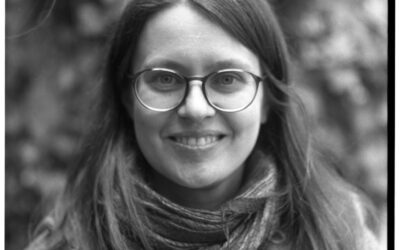AABS is pleased to recognize Oliver Aas for the completion of the grant associated with his dissertation “Figures of the Arctic in the Anthropocene,” for which he received the AABS Dissertation Grant in the 2021-2022 cycle.

©Oliver Aas, 2023
Oliver Aas is a PhD candidate at Cornell University in Ithaca, New York, where he is completing his dissertation on the cultural understandings of the Arctic melt. Currently, Aas is also a predoctoral fellow at the Kunsthistorisches Institut in Florence. Working at the intersection of literary and visual studies, his project looks at how the Arctic becomes not only an environmental site but also a way of thinking and doing politics, revising some of the well-accepted notions and concepts that have circumscribed the Arctic. Aas’s other forthcoming work includes a paper on Estonian “low-brow” music; formlessness as a key epistemological concept for environmental thought; the ambivalence of socialist realism; and, indeed, the Arctic.
The Impact of an Award: Report from Oliver Aas
After the completion of his grant, Oliver Aas submitted a reflection to AABS.
We thank him for his permission to publish his thoughts, which have been lightly edited.
I began my PhD journey in 2018 at Cornell University, in a beautiful and slightly remote part of the New York State, and I anticipate to defend my PhD project in Spring 2024. Prior to that, I studied at Maastricht University (Netherlands) and Central European University (Budapest), where I earned my BA and MA degrees respectively. My PhD-project, tentatively titled, “Figures of the Arctic in the Anthropocene” analyzes the circumpolar worlds as an amalgamation of ideas and, indeed, figures, that continue to influence our understanding of climate change. An inter-disciplinarian as well as a student of humanities, I’ve been interested in environmental humanities, philosophy, social theory, Eastern European culture, Scandinavian studies and history for a long time. But it was not until I “discovered” the Arctic as a topic that I could bring together different national traditions and my often disparate interests. Given that the US, Britain, Russia, Norway, Sweden, as well as Estonia—areas that had all interested me individually earlier—all had different historical convergences with the North, I started thinking about connections between different imaginaries of the Arctic.
During the very early stages of the project, it was a great discovery that Estonia, despite its relatively small size, has a rich history of Arctic entanglements that thus far has been discussed mostly in the historical disciplines rather than the so-called interpretative humanities. Early on, I contemplated writing the entire project about the Estonian Arctic imaginary, however, I soon realized that the Estonian Arctic imaginary can only be understood through its inter-textual relationship to various cultural encounters. While there are certain national specificities, the vision of the Estonian Arctic today, I would argue, is part of a larger trans-national orientation that pervades much of the Western European discourse on the circumpolar worlds.
The AABS grant, while used for academic purposes like travel, summer school, but also—and this should not at all be under estimated!—daily maintenance, gave me the greatest gift a scholar can have: time. And for that, I am truly thankful. Being something of a slow writer, the time it takes for an idea to mature is often under-appreciated. The extended time has also allowed me to prepare further material for publication as well as branch out from primary project and begin work on (what will hopefully be) my next project. The funding from the AABS came to me at a moment when I needed to make changes to the project to make it more feasible, given the pandemic had radically altered access to archives; travel had become very complicated; and interaction with scholarly communities by way of conferences and workshops had all but stopped. In other words, I had to re-think my project. It is not at all an exaggeration to say that the additional funding from the AABS gave me a moment to breathe and re-calibrate my project that had grown perhaps too big for its own good. Being able to hone a more specific focus to the project is a debt to the grant.
During the last two years, while writing my dissertation, I’ve also been a Fellow at IFZO (Interdisicplinary Center for Baltic Sea Region Studies) as well as at the Kunshistorisches Institut in Florence Max Planck. Stays at those institutions have afforded a polyvocal approach to my project: one that is focused on establishing the specificity of the Baltic Sea region studies as well as an expansive understanding of inter-connections in the region; the second that has an art historically and methodologically defined object of study. As an inter-disciplinarian, borrowing from different fields like history, literature, and art, such input has been really important and, it has also pushed my thinking further, especially when it comes to thinking about dialogue between different disciplines in a way that does not appear forced or shallow. I am thankful for comments I received during my talk(s)—the afterlife of the Arctic and the uses and abuses of polar regions or what I call the “untimely Arctic”—at IFZO as well as other conferences and venues where I’ve presented my work on the afterlife of the Arctic over the last two years. I am modestly hopeful that my contribution, however slight, will be a welcome addition to the budding field of Estonian environmental thought (or “ecocriticism” as it called now).
My time at IFZO and the KHI has made me aware of several things, chief among them a better-tuned sensibility to how things, and especially ideas, travel. Talking to different scholars, all working on the Baltic Sea region, and even though at times our topics varied greatly, alerted me to understand that it is not always about the similarity of research projects but the types of questions you ask as you approach your object of study. Categories like “Estonian” and “Baltic” are not self-evident but rather have to be specified in their historical-discursive context. At KHI, in turn, I’ve been really amazed by the methodological rigor of art history—to really understand how art can be not only contextualized and historicized but interpreted in a way that opens it up for new discussions. Those two experiences—and especially the ability to have been in those places physically and talk to other scholars— have been important for me as I (hopefully) continue to develop as a junior scholar.
In greater detail, my primary academic interest has been the Arctic, not only as a geographical region but also a figure that, on one hand, is a “real” place with real earthly coordinates but, on the other hand, it is also a place of mystery and elusiveness. That means, we can talk about two different things, the place of the “real” Arctic where people live and the mythological one that exists as a mental image. As Arctic historians know, sometimes fictions and/or rumors have a more tangible impact than truth itself: for a long time, the pull towards the magnetic Arctic was circumscribed by a sheer desire for the unknown, or what the historian Glyn Williams calls “the voyages of delusion.” In other words, the Arctic (and by extension the Antarctic) are no ordinary places—they exist out of our immediate reach and often come to us via second hand accounts.
After all, a country like Estonia that has no immediate border with the Arctic region nevertheless has not only participated in polar exploration and the production of polar knowledge but also has a certain idea of the place that is usually fostered through literature, film, television, documentary, social media and so on. Interestingly, even though many places once deemed “exotic” have lost their allure, the polar regions still continue to excite the public writ-large. Today, however, the biogeochemical reality of circumpolar worlds is changing: it faces unprecedented melting. In cultural terms, this means that our eyes are once again directed towards the Arctic. I like to think of this moment as a kaleidoscope—it brings together “the old” as well as “the new,” fact and fiction.
Methodologically, the project builds up on recent interest in “world literature,” “global art,” “world history” and other adjacent and emergent fields that aim to bring together different national registers through shared conceptual unity or historical contiguity. Working across American, British, Scandinavian, and Baltic (Estonian) literary and visual examples, the primary focus of the project is to understand how, on one hand, the ideas of the Arctic travel as they “move” from one geographical place to another, and, on the other hand, how such ideas and images continue to have influence today (e.g. is the Estonian imaginary of the Arctic different than the British one?). Though the list of national traditions may seem incomprehensibly vast for a single project, one will quickly realize that the idea of the Arctic—as it exists in dominant discourses—can be quite similar, probing further question about its politics. Part of my aim has been thus to “de-naturalize” certain common visions by asking how they come to be, how they are disseminated and for what purposes they are used. In my project, the question of afterlife has been a central focus because I have been trying to understand how our earlier “experiences” of the polar regions continue to reverberate today. Today, moreover, the question of afterlife acquires a political dimension. Given that we are culturally inclined to first think of the Arctic through its spectacular history, does it also change the way we think of the polar melt? In short, my project oscillates between images, texts and artefacts of yesteryear as well as their resurgence and relevance today.
As it were, I did not arrive at the “Estonian Arctic” before I had already started the work on analyzing the idea of the Arctic writ-large. Understanding how multifaceted the history of Estonian Arctic is, I began to think about how the different national histories of the Arctic could be brought together to offer novel insight on the circumpolar space. Time was on my side and the stars aligned—the last ten years have been very productive in re-articulating a relationship with the North in Estonian culture. Widely publicized voyages to the Arctic, the surge in interest in Juhan Smuul—a Stalinist writer who won the Stalin Prize for Literature in 1951 and the Lenin Prize in 1961—whose polar travels have long been a subject of scholarly interest, novel exploration writing by those that had visited the North recently, the question of the melting Arctic in the Anthropocene as well as a slew of artists (e.g. Holger Loodus) that take up the polar regions in their work has made the Arctic, once again, a “hot topic.” In the newer visions of the Arctic, the specific of Estonian Arctic exploration (see “Eestist pärit Arktika-uurijad” by Vassili Passetski, for instance, for earlier accounts) seems mostly to have been sidelined, it has been replaced with a trans-national idea of the Arctic. However, new iterations still offer creative re-interpretations of the North. (Here, the question of which Arctic is “European,” “Estonian,” or “Scandinavian” etc. is made central again. With the ever-increasing frequency of textual and. visual exchanges, it becomes much more difficult to identify something as belonging to a single national register.)
One of the surprising—or perhaps not so surprising—findings is that the Arctic figures and doubles as a means of doing politics. There’s a saying that goes something like this: the first battle is fought on the battleground, while the second battle is that of memory. The afterlife of the Arctic—the battle of the memory—is formed at the intersection of real-life historical data and experience but also of cultural memory. When we conjure images of the exploration era before our eyes, we will no doubt be reminded of the 19 th century images of fur clad men stuck in ice fighting polar bears. But if the 19 th century images of the Arctic were used to drum up support for further exploration and to fund the costly construction of boats and so forth, today the figures of the Arctic—note the multiplicity rather than singularity!—also become attached to various political projects. Even though the same site of the Arctic is used, it paves way for radically different political projects. In the Russian case, the Arctic is often related to a politics of anticipation and futurity, waiting for easier access to minerals like gas and oil that have been hitherto inaccessible; in many European discourses—the figure of the melting becomes attached to a loss of the world in the context of anthropogenic climate change (see for instance the artwork by Olafur Eliasson); in Estonian case, as evidenced by artists Holger Loodus and Silvia Parmann, for instance, the Arctic becomes a test case to both test human limits but also to think about the meaning of “edge of the world” at a time where borders have become particularly porous. These artists and thinkers draw on the visual-textual rhetoric of the old but add a contemporary problematization to their works. Unpacking the figure of the Arctic in its historic and local specificity can tell us not only about how ideas travel but also how we relate to the enigmatic site of the polar regions. In other words, the Arctic is not only a figure but importantly a way of thinking through different problems.
And, once again, I would like to thank the AABS for their continued support and helping me facilitate these experiences.
– Oliver Aas, 2023
What is the Dissertation Grant?
AABS Dissertation Grants for Graduate Students are grants of up to $4,000 to support doctoral dissertation research and write-up in any field of Baltic Studies. Funds may be used for travel to research site, equipment, duplication or other needs as specified. Proposals are evaluated according to the scholarly potential of the applicant, and the quality and scholarly importance of the proposed work, especially to the development of Baltic Studies.
The application deadline for academic year 2023-2024 was February 1, 2023. Applications were evaluated by the AABS 2023–2024 Grants Committee consisting of AABS VP for Professional Development Dr. Kaarel Piirimäe, AABS President Dr. Dovilė Budrytė, and AABS Director-at-Large Dr. Daunis Auers. Award notifications were made in April 2023.
Other Grants and Fellowships News
Sophie Peng Awarded 2024-2025 Baumanis Grant
The Association for the Advancement of Baltic Studies is pleased to announce that Sophie Peng has been awarded the 2024-2025 Baumanis Grant for Creative Projects in Baltic Studies for her project “Lace Narratives: Hand-work (EE: Käsi-Töö)." The Baumanis Grant is an...
Jelena Šalaj Awarded 2024-2025 Baumanis Grant
The Association for the Advancement of Baltic Studies is pleased to announce that Jelena Šalaj has been awarded the 2024-2025 Baumanis Grant for Creative Projects in Baltic Studies for her book project "North of Photography." The Baumanis Grant is an award made to...
Ornela Ramašauskaitė Awarded 2024-2025 Baumanis Grant
The Association for the Advancement of Baltic Studies is pleased to announce that Ornela Ramašauskaitė has been awarded the 2024-2025 Baumanis Grant for Creative Projects in Baltic Studies for her project "Art Across Borders: The Baltic Visual Legacy Project." The...




